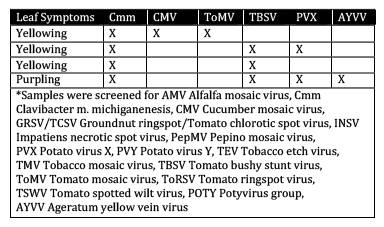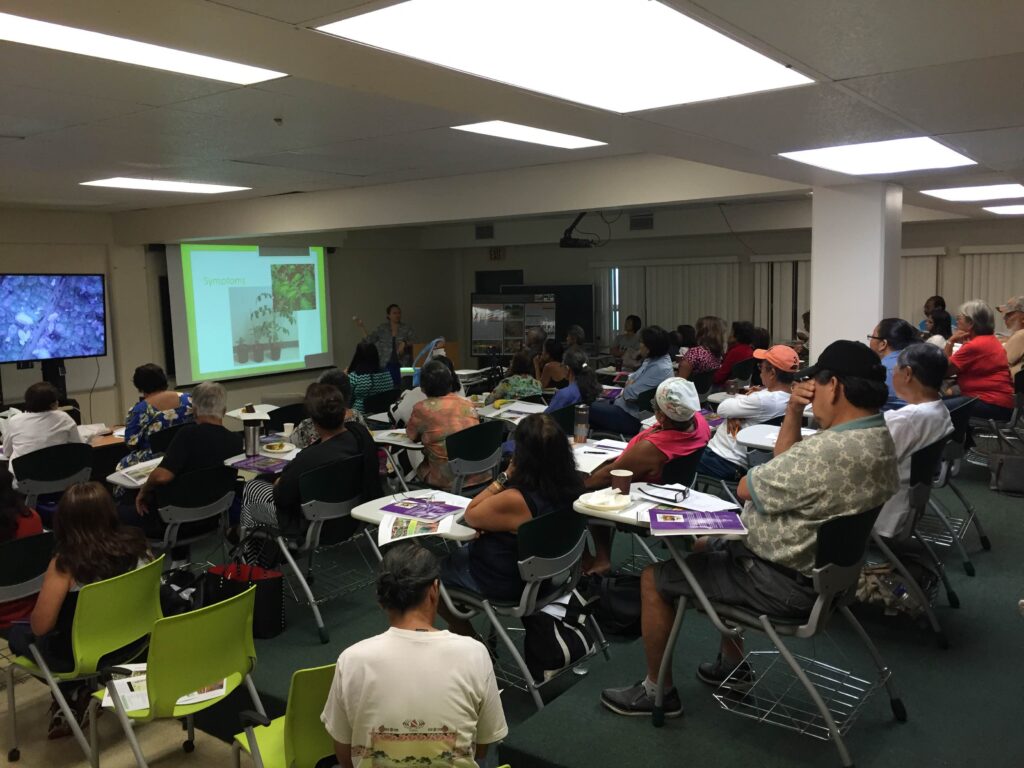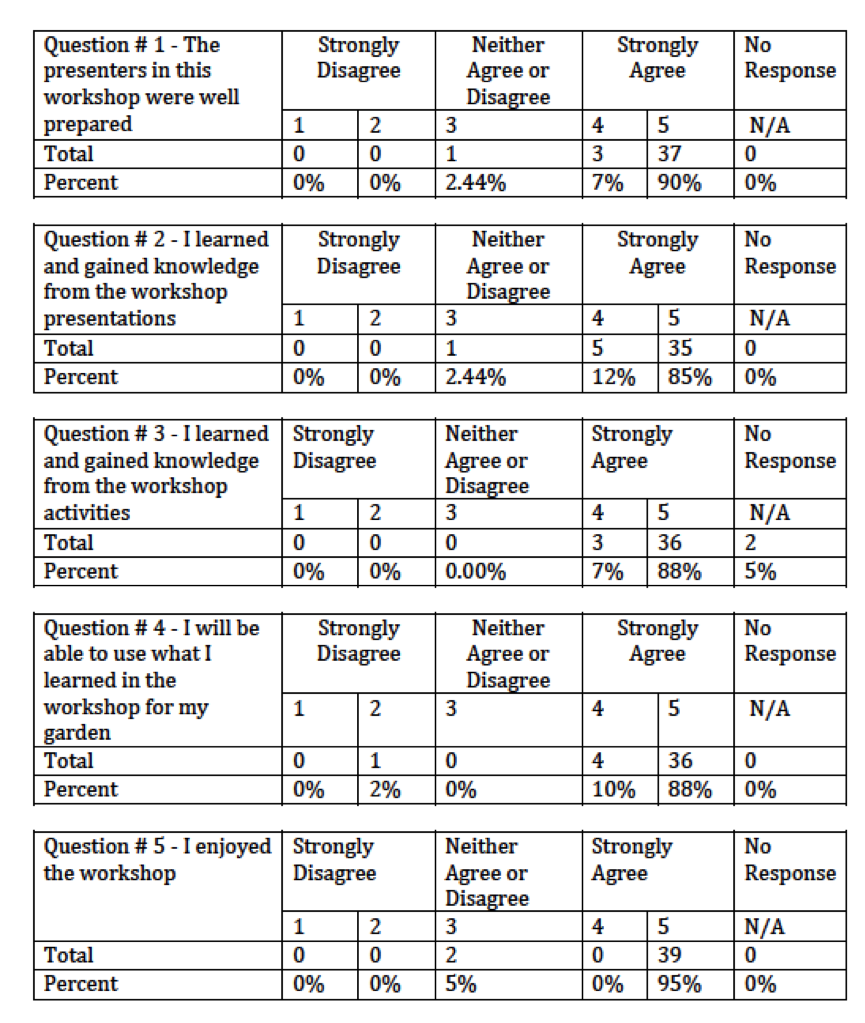2016 Annual Report for OW14-026
Screening tomato varieties for suitability on Guam in response to the arrival of Tomato leaf curl Guam virus in the Western Region
Summary
This report covers the period of April 1, 2016 to January 15, 2017. During this period, four tomato leaf samples exhibiting virus symptoms were sent off island for DNA analysis. The results show that Guam’s tomato crops are suffering from a complex of virus diseases and a bacterial disease. Also, a workshop was held for 55 farmers and home gardeners at the University of Guam where the results of this project’s tomato virus resistance variety trial were presented. Finally, Ageratum yellow vein virus (AYVV) brochures were distributed at meetings of the Guam’s Farmer Cooperative Association, and Guam’s Northern and Southern Conservation Districts.
Objectives/Performance Targets
Objectives and Performance targets as stated in the proposal:
Objective 1: Improve the ability of producers to screen tomato varieties for Tomato leaf curl Guam virus (TLCGV) resistance and suitability for production on Guam. Activities for Objective 1: (1) June 2014, after consulting with project statistician, PI will meet with producers and instruct them on virus identification and score tomato varieties for resistance to TLCGV and suitable for production on Guam. (2) Producers will be given pre and post-tests to measure knowledge gained. (3) Producers will review the characteristics of 40 varieties prepared by the project graduate student and PI and select the 18 varieties that will be included trial. (4) August 2014, PI and graduate student will assist each producer with a wet season varietal screening trial. (5) October 2014, producers will host a producer field day and members will reevaluate plots. Rating will continue until December 2014. (6) March 2015, producers begin dry season varietal trial. (7) May 2015, producers will host a producer field day and members will reevaluate plots. Plot will continue until July 2015. (8) October 2015, project statistician will run a MANOVA of the response variable data and interpret screening trial results for PI and producers.
Objective 2: Bring awareness to producers and the public about Guam’s whitefly transmitted tomato virus and steps that can be followed to reduce its impact. Activities for Objective 2: (9) December 2015, PI and producer will host a workshop onsite at one of the variety trial locations for the islands farmers, home gardeners, NRCS, and the Department of Agriculture. After the workshop, an outreach survey will be conducted similar in design and purpose to the one posted on the SARE program website. (10) January 2016, Information from the workshop will be placed in a brochure and posted on the UOG/ANR webpage. (11) March 2016, a YouTube video will be created about TLCGV using information in the brochure.
Objective 3: Bring about the adoption of farm practices that will reduce the occurrence of TLCGV in tomato fields and result in produce production returning to pre Tomato leaf curl Guam virus levels. Activities for Objective 3: (12) May 2016, Graduate student will distribute TLCGV brochures at meetings of the Guam’s Farmer Cooperative Association, and Guam’s Northern and Southern Conservation Districts. (13) December 2016, a longterm outreach survey will be created to assess changes in farmer attitude and adoption of control strategies. The project statistician will assist in questionnaire development and interpretations. (14) February 2017, PI, graduate student, and statistician will prepare and submit final project report.
Accomplishments/Milestones
This is a 3rd year annual report: reporting period April 1, 2016 to January 15, 2017.
The grant end date is March 31, 2017.
Note: The plant virologist from the USDA-ARS U.S. Vegetable Laboratory who originally named the virus Tomato leaf curl Guam virus (TLCGV) from the samples we sent him has renamed the virus as Ageratum yellow vein virus (AYVV) Guam strain.
1) Four new tomato leaf samples with virus symptoms were sent to the USDA-ARS U.S. Vegetable Laboratory for DNA analysis. The virologist tested the samples for AYVV. However, noticing different symptoms in the leaf samples, he then sent processed samples to Agidia Inc. for further testing. Analysis of the four samples by Agdia Inc. raises the possibility that the failure of tomato production on Guam is due to a complex of viruses along with the bacterium Clavibacter m. michiganensis (Table 1).
Table 1. Positive test results for four tomato samples analyzed by the USDA-ARS U.S. Vegetable Laboratory and Agdia Inc.

2) A workshop was held on August 06, 2016 at the University of Guam, College of Natural and Applied Sciences building concerning the results of this project. Fifty-five farmers and home gardeners attended.
The workshop began with the welcoming session that included distribution of useful handouts, the latest version of the Eggplant, Pepper, and Tomato Production Guide for Guam (a publication from a previously funded WSARE grant) and a pre-test. Mr. Jim Hollyer, Associate Director of Extension & Outreach welcomed the participants with a short presentation on Extension’s role in the community. Dr. Robert Schlub, the Project Coordinator for this grant gave a short overview of the project. Ms. Sheeka Tareyama, an Extension Associate working on the project then followed with her presentation, which include a producer evaluation of the variety trials (Figure 1). Following her presentation, the participants completed a post-test and workshop evaluation. The presentation can be found online at the following link: https://drive.google.com/open?id=0By5n4w26eOwGVGZGNTZlSnZKZk0

Figure 1: Extension Associate Ms. Sheeka Tareyama discusses the results of the WASRE Professional Producer funded tomato virus resistance variety trial with 55 Guam farmers and home gardeners.
3) Ageratum yellow vein virus (AYVV) brochures were distributed at meetings of the Guam’s Farmer Cooperative Association, and Guam’s Northern and Southern Conservation Districts. The brochures can be found at the following link: https://drive.google.com/open?id=0By5n4w26eOwGV0s0Tlk4R1Jsc1E
4) Objectives not yet completed: YouTube video and a long term outreach/outcome survey.
Impacts and Contributions/Outcomes
1) Analysis of the four new samples by Agdia Inc. raises the possibility that the failure of tomato production on Guam is due to a complex of viruses along with the bacterium Clavibacter m. michiganensis. More research needs to be done in this area.
2) Pre and post-tests were given to 55 farmers and home gardeners at the WSARE Professional Producer funded tomato virus resistance variety trial workshop. Pre-test scores averaged 40%, while the post-test scores average was 85%. This shows a significant gain in knowledge. Also, the results of the workshop evaluation questionnaire (Table 2) show that the workshop was a success.
Table 2: WSARE funded tomato virus variety trial workshop evaluation scores.

Collaborators:
Extension Associate
University of Guam
CNAS/CES
UOG Station
Mangilao, GU 96923
Office Phone: 6717352094
Extension Associate
University of Guam
CNAS/CES
UOG Station
Mangilao, GU 96923
Office Phone: 6717352094
137 Balimbines Court
Liguan Terrace
Dededo, GU 96929
Office Phone: 6717979493
174 Chuchuko Drive
Dededo, GU 96929
Office Phone: 6716321610
P.O. Box 20487
GMF, GU 96921
Office Phone: 6716872139
PMB 354
Tamuning, GU 96913
Office Phone: 6714838886